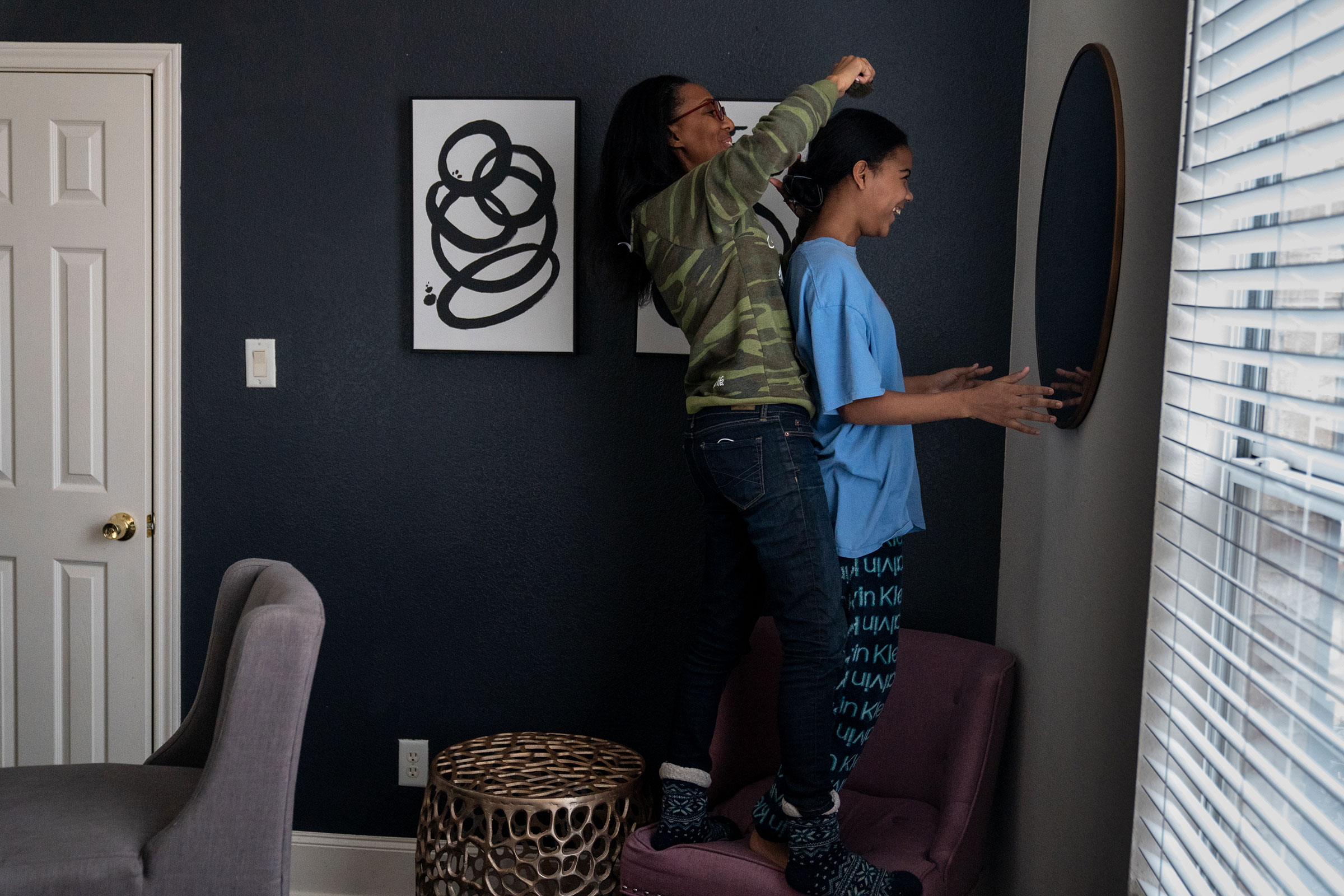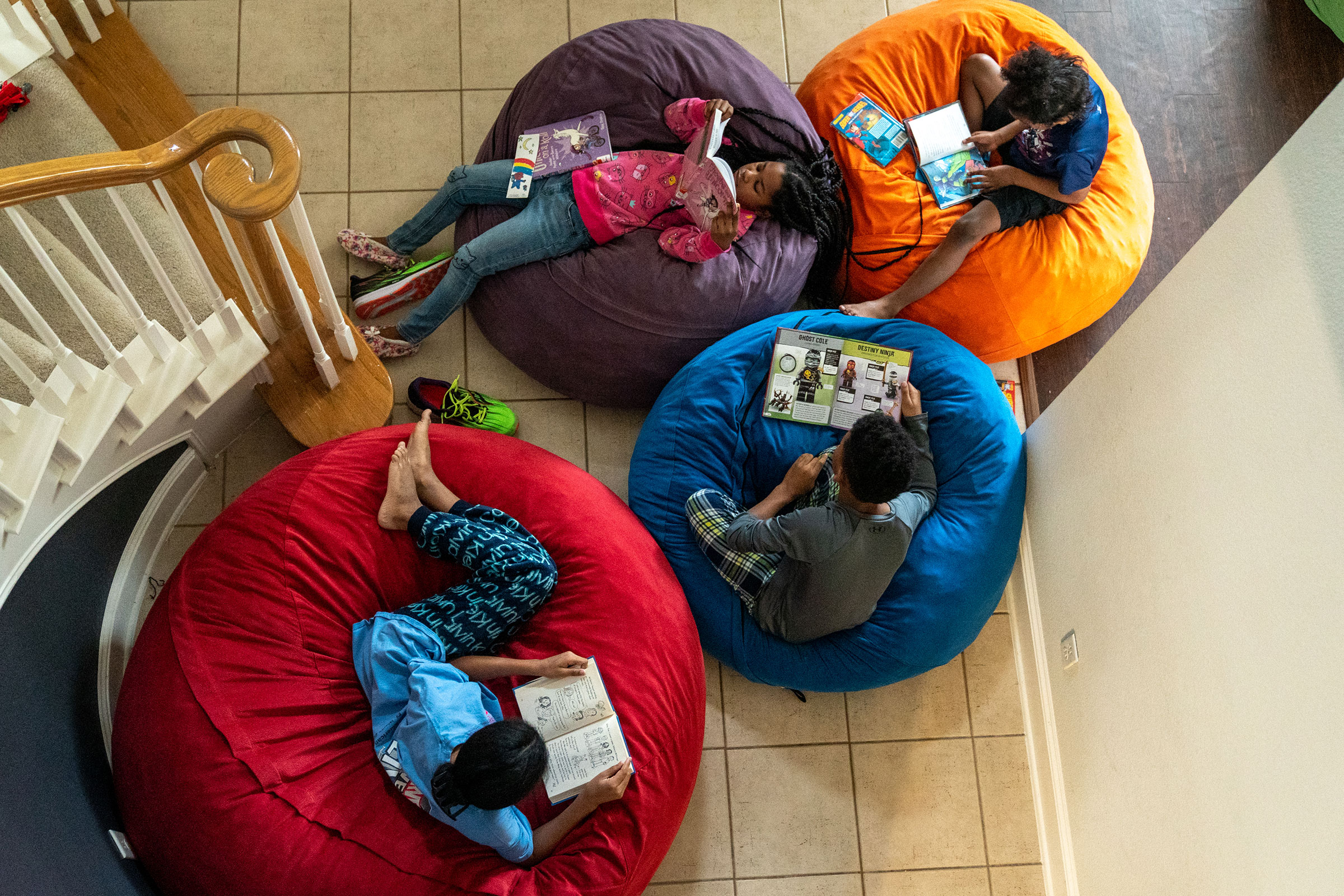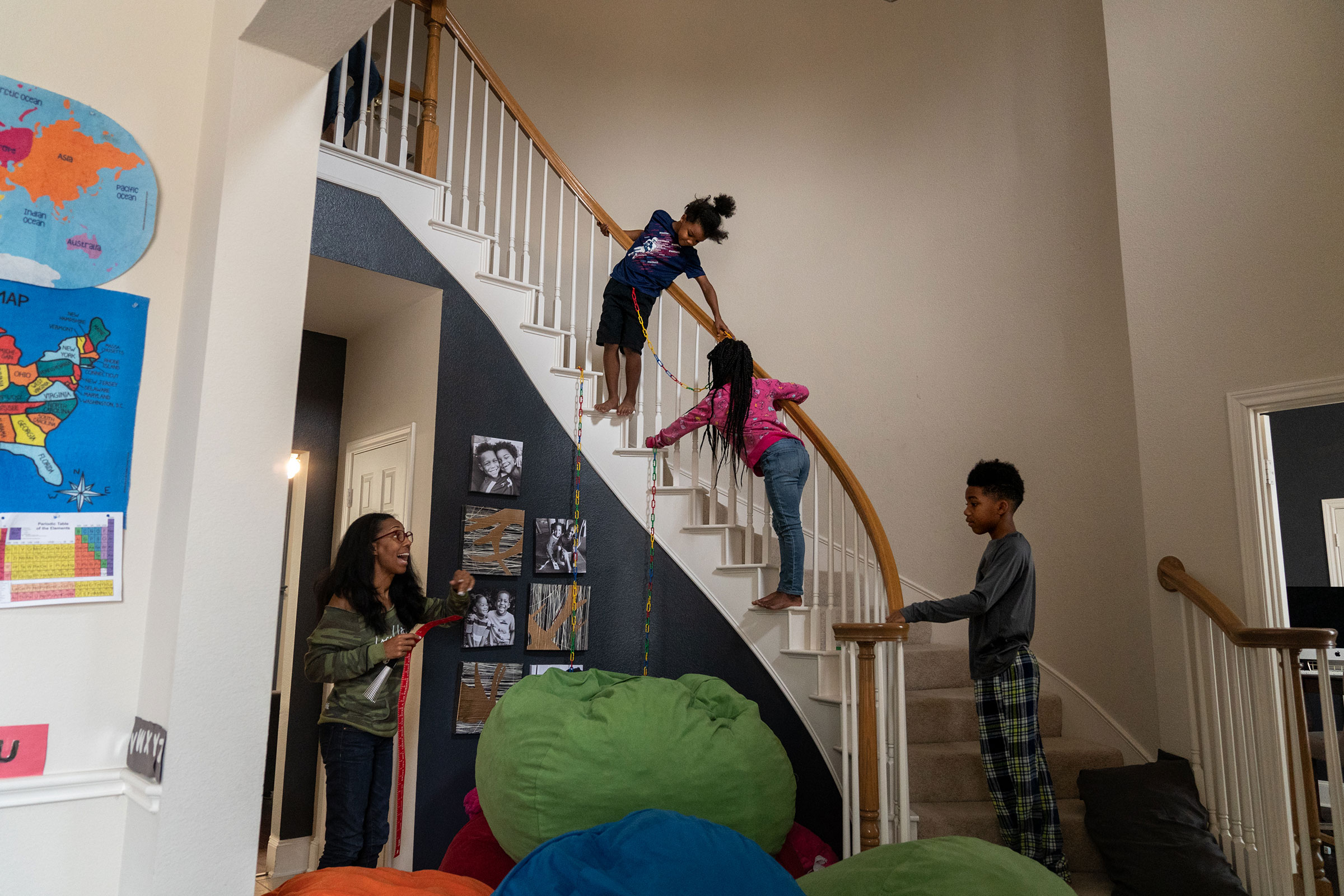For Shari Rohan, it was a social-studies lesson that described enslaved people receiving “on-the-job training.” For Zanetta Lamar, it was the fact that her son was the only Black student in his grade. For Andrea Thomas, it was realizing just how little she had learned about Black history while attending both public and private schools.
“I did not want my children to have that same experience,” says Thomas, who, along with Rohan and Lamar, is now homeschooling her children, becoming part of a movement that once was seen as the domain of white, conservative families. “I wanted them to have a deeper understanding of history and the flaws within our history.”
Homeschooling increased nationwide after the pandemic disrupted in-person learning; among households with school-age children, the percentage who reported homeschooling them rose from 5.4% in April 2020 to 11.1% in October 2020, the last week for which those figures are available, according to the U.S. Census Bureau’s Household Pulse Survey. The increase was most significant among Black families, about 3.3% of whom were homeschooling in spring 2020. By fall 2020, 16.1% were homeschooling, according to the survey. And as that population has grown, so have the curriculum resources and support groups.
Read more: Inside the Fight Over What Kids Learn About America’s History
While COVID-19 was a catalyst, many Black parents, concerned about racism in schools and frustrated by the prevalence of white-washed history lessons, have also turned to homeschooling as a way to take control of their children’s education and give them an unvarnished version of U.S. history, even as such efforts come under attack in school districts around the country.

“Homeschooling has become such a refuge for many families, Black families in particular, that they don’t have to go to the under-resourced school that they were assigned,” says Cheryl Fields-Smith, an associate professor at the University of Georgia’s Mary Frances Early College of Education, who has researched homeschooling among Black families. “They have an option where someone can create for them a really positive, nurturing, learning environment.”
The challenges faced by Black children in America’s public schools are well-documented. Black students are disciplined at higher rates than their white peers. Districts that serve mostly Black and Latino students receive far less funding than those with mostly white students. And Black students are unlikely to be taught by Black educators, as only 7% of public-school teachers are Black. On top of that, many school districts are now facing calls to remove books by Black authors from school libraries and to restrict how teachers discuss race in the classroom.
“If you send your child to school, and those ideals are there, you have to rescue them in a way,” says Fields-Smith. “Out of frustration, they realize, ‘You know what, I can do a better job than this.'”
Thomas, whose children range in age from 4 to 12, recalls visiting her daughter’s first-grade private-school classroom a few years ago for a Thanksgiving activity that painted a rosy picture of the relationship between pilgrims and Native Americans. “I thought, ‘Oh, I’m doing my child a disservice,'” she says. “That’s obviously wrong.”

Since she started teaching her kids at their Richardson, Texas home in 2020, Thomas has used a U.S. history curriculum from Woke Homeschooling, a platform created by Delina Pryce McPhaull, who struggled to find a history curriculum she liked when she first began homeschooling nearly 10 years ago. She found that most had a conservative bent, included religious teachings and leaned heavily on the perspectives of white people within U.S. history.
“I got tired of reading about white people, white people’s experience,” says Pryce McPhaull, who is Black and has always homeschooled her children, 12-year-old twins and a 14-year-old. “You get tired of the same perspective the whole time.”
She crafted her own curriculum, marking up her children’s textbooks, researching alternative readings, removing a lesson involving the Confederate anthem, “Dixie,” and adding a lesson about “Lift Every Voice and Sing,” long considered the Black national anthem.
She made that curriculum public in 2019, offering it as a digital download for other parents, hoping to give them the tools to guide their children through tough conversations about harsh realities. She saw more than 2,000 curriculum downloads in August 2020 compared to about 300 in August 2019, attributing the spike to the rise in homeschooling during the pandemic and to the increased focus on systemic racism following the death of George Floyd. Her U.S. history curriculum for the third- to seventh graders costs $50, and her high-school curriculum comes in two parts for $60 each, all promising to make the history of Native Americans, African Americans and immigrants “more than an after-thought.” More than 700 families have enrolled in Woke Homeschooling online courses since September 2020, she says.
“I like to say, ‘Let’s tell the truth and see what happens.’ Because we haven’t been telling the truth,” she says. “We haven’t, as a nation, as a whole, grappled with history in a truthful way. Some parents have determined that we’re going to do this differently.”

The history of homeschooling
The fact that Pryce McPhaull couldn’t find many curriculum options that weren’t written from a conservative, Christian perspective, and that her lesson plans have generated so much interest, reflects the changing demographics of homeschooling.
An early wave of homeschooling in the 1970s was driven by left-leaning parents more aligned with the counterculture of the 1960s. Educator John Holt coined the term “unschooling.” Holt advocated for child-directed learning and less emphasis on testing, and he encouraged families to leave the public school system in favor of less rigid styles of education.
But during the 1980s and ‘90s, homeschooling became a more conservative movement, overlapping with conservative ideals about limited government, parental rights and religious freedom.
Republican presidential candidates started to appeal to homeschooling parents for political support, and the Home School Legal Defense Association was founded in 1983 to lobby lawmakers and provide legal services to families fighting for their right to homeschool.
In 2016, about 60% of self-identified homeschool parents voted for Republican Donald Trump, according to research by Heath Brown, an associate professor of public policy at the John Jay College of Criminal Justice who has studied the history of conservative activism around homeschooling. But that has been slowly shifting, with more homeschooling parents identifying as moderate, and the change was accelerated by the pandemic.

The number of homeschooled students nearly doubled from 1999 to 2016, the most recent year for which data is available, when nearly 1.7 million students were homeschooled, about 3.3% of all students, according to the National Center for Education Statistics (NCES). The majority of those students (59%) were white, while 26% were Hispanic and 8% were Black. Those who chose to homeschool most often cited concerns about the school environment as the main reason, followed by dissatisfaction with academic instruction and a desire to provide religious instruction.
The increase in homeschooling today is visible across racial groups, rising to 12.1% of Hispanic households and 9.7% of white households in October 2020, according to the Census survey data.
Some white parents who made the shift to homeschooling did so as part of the backlash to critical race theory, objecting to how racism is discussed in public schools. Aly Giles, who is white and lives in Tennessee, said she thinks public schools have become too liberal, and she didn’t want her son “to feel guilty for a past that he had nothing to do with.” Giles started homeschooling her three school-aged children in 2020. “I can’t change the whole public school system, but what I can do is take my kids out of it,” she said.
Critical race theory is a graduate-level academic framework that explores how institutions perpetuate racism. School districts across the country have emphasized it is not being taught in K-12 schools, but it has become a catch-all term among critics, who argue that lessons addressing systemic racism will divide children and make white students uncomfortable.
Brown says homeschooling parents have long been motivated by a desire for more control over their children’s curriculum. “That includes the choice of textbooks, the choice of subject matter,” he says. Black parents who are now pursuing a more diverse, comprehensive history education are the latest example.

‘I could not send her back there’
Shari Rohan reached a breaking point with her daughter Sofia’s public school in June 2020, when she was able to see and hear what Sofia, who is biracial, was learning in fourth grade in Watervliet, N.Y. Rohan was concerned about one assignment that described enslaved people receiving “on-the-job training” and another that described the United States as a “blue-eyed and ready nation.”
“These lessons add to the complete erasure of the atrocities faced by Native and Black people throughout history. I would like to know what the school is doing to encourage accurate language and portrayal of historical events,” Rohan wrote in an email to her daughter’s elementary-school principal, who said she would work with staff to rewrite their curriculum and “increase our understanding of race and racism.” But for Rohan, the response seemed like too little, too late.
Read more: Applying to College Was Never Easy for Most Students. The Pandemic Made it Nearly Impossible
“Seeing the actual curriculum, and the response from the school to that curriculum, just made it ethically impossible for me to send her back,” says Rohan, who began homeschooling Sofia, now 11, in September 2020. “I’m a single parent, and I work outside the home. But I could not send her back there.”
In an email, Donald Stevens, superintendent of Watervliet schools, acknowledged that the material used as part of those assignments was “inappropriate.” “The material and its use is not reflective of our commitment as educators and as a school district to educational equity for all students,” he said, adding that the district has been reviewing its curriculum to “ensure it reflects our commitment to diversity, equity, and inclusion” and is creating a resource bank for teachers with materials that are “reflective of all demographics and backgrounds.”
“We are determined to continue to move forward to ensure an equitable educational experience for all,” he said.


At home, Rohan has prioritized lessons on the Black Panthers’ community work and Rosa Parks’ training as an activist. She taught her daughter about the history of colonization in the U.S. and how the country’s Founding Fathers were also slave owners, centering diverse perspectives with each lesson.
“That history is so important to understand why everything is happening today,” Rohan says. “Without that history, an accurate history, this is why we are where we are.”
In Fredericksburg, Va., Odori Pendleton was a public-school teacher for 11 years before she started homeschooling her two children, now 8 and 12, in 2017 after witnessing too many examples of Black children being mistreated in school.
Pendleton wanted to remove her children from that environment, especially after her son was diagnosed with autism and ADHD. “They’re going to see him as a troubled Black boy before they see that he is actually a savant,” she thought.
Many parents who are now taking control of their children’s education are also motivated by a desire to make sure their kids are learning more than they did in school.
“I remember feeling as though Black history was boxed in. We talked about slavery and civil rights, and that’s it,” says Kerai Riddle, a mother in Illinois who started homeschooling her three children in October 2020. Her 12-year-old daughter, who was in public school until fifth grade, had complained that when Black History Month rolled around each February, it felt like her class only learned about Martin Luther King, Jr., skipping over other influential Black leaders.

Riddle recently taught her daughter about Ida B. Wells, a Black journalist who campaigned against lynching, someone she suspects her daughter wouldn’t have learned about in a traditional classroom.
Pryce McPhaull, the creator of Woke Homeschooling, realized the curriculum was necessary after participating in a racial justice study group in 2015, when it became clear how much her own public-school education had left out. She barely knew anything about the Reconstruction era following the Civil War. And while she was familiar with the term “Jim Crow,” she knew little about the many laws that had enforced segregation.
She wanted her children to have a better understanding of the legacy of racism in U.S. history as they reckoned with ongoing examples of racism and police violence, including the death of Michael Brown, an unarmed Black teenager who was fatally shot in 2014 by a white police officer in Ferguson, Mo.
“This isn’t just something happening out of the blue. This isn’t an anomaly,” says Pryce McPhaull, who lives in Keene, Texas. “It was important for my kids to have that historical context.”
She has been grateful to be homeschooling her kids amid the backlash to critical race theory in her state. Texas Gov. Greg Abbott has said he wants to “abolish critical race theory.” A new Texas law aims to restrict how teachers discuss race, gender and other issues in the classroom. It says public school teachers “may not be compelled to discuss a widely debated and currently controversial issue of public policy or social affairs” and requires representatives from every school to attend a training program on how to teach about race and racism.
Conservative parents and politicians in the state have also launched an effort to ban certain books from school libraries, targeting those that deal with racism and feature LGBTQ characters.

“They’re basically banning anything that might make white students feel uncomfortable,” Pryce McPhaull says. “When I hear that, I’m reminded of when I was in third, fourth grade, learning about the slave trade in my history class. I was the only Black child, or one of two Black children in the classroom. I didn’t have a Black teacher until I was in college. In that environment, I was uncomfortable learning about the slave trade with everyone’s eyes on me. I remember that feeling distinctly.”
When she taught her own children about slavery, she did so more carefully, engaging their questions and checking in how it made them feel.
“We don’t shy away from hard truths,” she says. “It doesn’t disappear if we don’t study it.”
‘We can’t remove them from America’
At the same time, not all problems can be solved by removing children from schools that aren’t serving them.
Zanetta and Cory Lamar, who live in Naples, Fla., sent their son to public school and private school before withdrawing him to homeschool. “I thought if I paid a lot of money and put him in private school, I could pay someone to treat him well,” Zanetta Lamar says. But her son, who knew what racism was by the time he was 6, was the only Black child in his grade, and there were some instances of racism on campus, in addition to their health concerns about COVID-19.
“It almost was the concern of what could happen,” she says. “We’re just trying to protect our kids.”

She and her husband are both physicians, but he resigned from his job in January to homeschool their 10-year-old son and 6-year-old daughter full-time. And while they’re happy with their decision, they know it won’t solve every problem.
“We can’t remove them from America,” Zanetta Lamar says.
And not everyone has the option to homeschool their children in the first place. While Cory Lamar has dedicated his time to educating his children, Zanetta Lamar, who still works full-time, is able to financially support their family on one salary. Rohan, a nurse instructor who can’t work from home, hired an au pair to look after her daughter during the day. While her husband works full-time, Thomas runs a business from home and has built her schedule to accommodate her children’s schooling, starting work at 5:30 a.m. so she can begin homeschool lessons by 10 a.m. For some families with less work flexibility and financial stability, that wouldn’t be possible.
“What I really hope is that, ultimately, public schools, districts, boards of ed, state boards of ed will take notice, and start to listen to what’s missing in our schools for Black children,” says Fields-Smith, the University of Georgia professor. “We can’t just do what we’ve always done. We must make some changes.”
Read more: How the Pandemic and Anti-Asian Violence Has Spurred Schools to Change History Lessons
Thomas, the mother in Richardson, says there are days when it’s difficult juggling “five different kids, five different personalities, five different grade levels.” But she has also found it refreshing to learn alongside her children, teaching them to ask questions about what they learn, to think about whose perspective it comes from and to fact-check the things they’re told.
In November, she tried to course-correct what her children had been taught about Thanksgiving previously, discussing the Native American tribes that lived here first and how colonists inflicted disease and violence. If more children have that kind of understanding, she argues, it might change the kind of country in which they grow up.
“We are feeding the next generation,” she says. “What are we feeding them?”
More Must-Reads from TIME
- Cybersecurity Experts Are Sounding the Alarm on DOGE
- Meet the 2025 Women of the Year
- The Harsh Truth About Disability Inclusion
- Why Do More Young Adults Have Cancer?
- Colman Domingo Leads With Radical Love
- How to Get Better at Doing Things Alone
- Michelle Zauner Stares Down the Darkness
Write to Katie Reilly at Katie.Reilly@time.com
